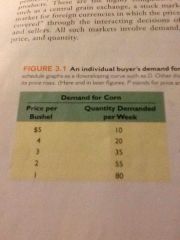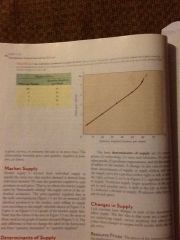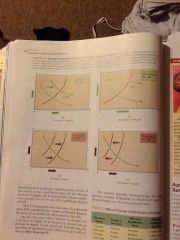![]()
![]()
![]()
Use LEFT and RIGHT arrow keys to navigate between flashcards;
Use UP and DOWN arrow keys to flip the card;
H to show hint;
A reads text to speech;
29 Cards in this Set
- Front
- Back
- 3rd side (hint)
|
Demand
|
A schedule or a curve that shows the various amounts of product that consumers are willing and able to purchase.
|
D-----
|
|
|
Demand schedule
|

|
D----- --------
|
|
|
Law of demand
|
The principle that an increase in a product's price will reduce the quantity of it demanded. (Other things equal/ conversely for decrease.)
|
A law
|
|
|
Diminishing marginal utility
|
The more you get the less satisfaction you get from it.
|
18 pizza
|
|
|
Income effect
|
A change in the quantity demeaned of a product that results from the change in purchasing power.
|
What can I buy?
|
|
|
Substitution effect
|
A change in the quantity demanded of a consumer good that results from a change in its relative expensiveness caused by a change in the products price.
|
Buying trucks
|
|
|
Demand curve
|
Curve illustrating demand.
|
Smooth curve
|
|
|
Determinants of Demand
|
Consumer tastes(preferences)
# of buyers in the market Income Prices of related goods Substitutes Compliments Unrelated goods Consumer expectations |
|
|
|
Normal goods
|
A good or service whose consumption increases when income increases and falls when income decreases. Price remains constant.
|
👩
|
|
|
Inferior goods
|
A good or service whose consumption declines as income rises. Price is held constant.
|
👸
|
|
|
Substitute goods
|
Products or services that can be used in place of each other. When the demand for one goes down the demand for the other goes down. Conversely when the device rises.
|
|
|
|
Complementary goods
|
Products and services that are used together. When the price of one falls the demand for the other increases.
|
Plants and garden tools.
|
|
|
Change in demand
|
A change in one or more of the determinants of demand. Moves left or right.
|
|
|
|
Change in quantity demanded
|
Caused by a change in the price.
|
|
|
|
Supply
|
A schedule or curve showing the various amounts of a product that producers are willing and able to make available.
|
|
|
|
Supply schedule
|

|
|
|
|
Law of supply
|
The principle that an increase in the price of a product will increase the quantity of it supplied. (Other things equal/conversely for decrease.)
|
Law
|
|
|
Determinants of supply
|
Resource prices
Technology Prices of other goods Producer expectations Number of Sellers |
|
|
|
Change in supply
|
A change in one or more of the determinants of supply. Change in the schedule and shift in the curve moves right to left.
|
|
|
|
Change in quantity supplied
|
Movement from one point to another on a fixed supply curve.
|
|
|
|
Equilibrium price
|
The price in a competitive market at which the quantity demanded and the quantity supplied are equal. No shortage or surplus No tendency for price to rise or fall.
|
|
|
|
Equilibrium quantity
|
The quantity demanded and supplied at the equilibrium price in a competitive market.
|
|
|
|
Surplus
|
The amount by which the quantity supplied of a product exceeds the quantity demanded at a specific price above the equilibrium price.
|
|
|
|
Shortage
|
The amount by which the quantity demanded of a product exceeds the quantity supplied at a particular price below the equilibrium price.
|
|
|
|
Productive efficiency
|
The production of a good in the least costly way.
|
|
|
|
Allocative efficiency
|
The particular mix of goods and services most highly valued by society. Minimum cost production assumed.
|
|
|
|
Price ceiling
|
A maximum legal price.
|
|
|
|
Price floor
|
A minimum price fixed by the government
|
|
|
|
Changes
|

|
|

